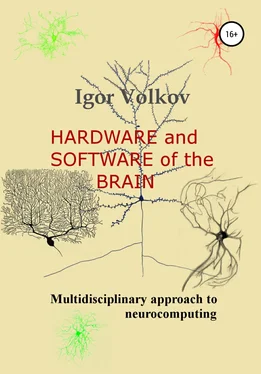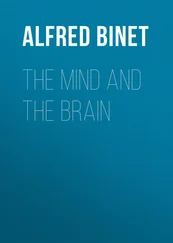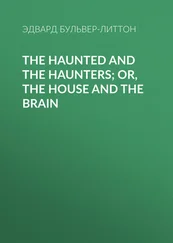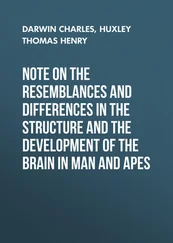Igor Volkov
Hardware and software of the brain
Copyright (c) I. Volkov, January 5, 2017 – May 10, 2022
Modern computers already surpassed complexity of the brain. What is more important, in the process of development, theoretical cybernetics elaborated numerous concepts and solutions which may be applied to living systems. The process is mutually beneficial. You explain how biological organisms operate and simultaneously get some hints about further development of machines.
The human brain is a live automatic control system. Hence it may be described in terms of modern cybernetics. It is very different from common computers, but the main concepts are applicable. A typical workable computer consists of the two main parts: hardware and software that is material and non-material halves. Accordingly, for humans we talk about the body and the soul. The term hardware is not very well suited because a half of the human body is water. Also objective phenomena behind the soul are much wider than just algorithms learned by a person. Nevertheless, the terms will be retained for compatibility.
Programmers of traditional computers know that software is heavily dependent on hardware. With the development of computer industry, large efforts were applied so as to achieve portability, but the talks is about a program which should run on 2 computers of the same type, but made by different manufacturers. It is obvious that if a different hardware has no some feature which is crucial for the program, then they are incompatible in principle. So we should begin from functional architecture of the brain, only then proceed to software which may run on this device.
Several latin words which are often used in medical literature
Lateral– located at the side.
Medial– located in the middle.
Rostral– shifted from the centre to the head.
Caudal– shifted from the centre to the tail.
Dorsal– back (humans) or upper (animals).
Ventral– front (humans) or lower (animals).
A coronalplane dissects a structure into ventral and dorsal parts.
A sagittalplane separates the right from the left.
When you disassemble an electronic device, it usually contains several blocks which are functionally different and also well separated. They may be mounted on different printed circuit boards or even in separate boxes. There is no such separation in the brain. It is a smooth 3D mass which may be structured only by morphology, that is microstructure of nerve cells and fibers. Moreover, if you look at a cross-section of the brain, you will see almost nothing. Thin serial slices used for reconstruction are just transparent. Only after special staining that microstructure becomes visible. The next question. Suppose you have singled out some part of the brain as structurally different. Who can guarantee that it is functionally different too? If it is functionally different, is this function confined within this structure only? Such questions resulted in several systems of anatomical terminology. Different brain subdivisions may overlap and all of them have quite remote relation to functionality. Nevertheless this knowledge is crucial because without it you won't be able to understand the location of a certain point from its description in special literature.
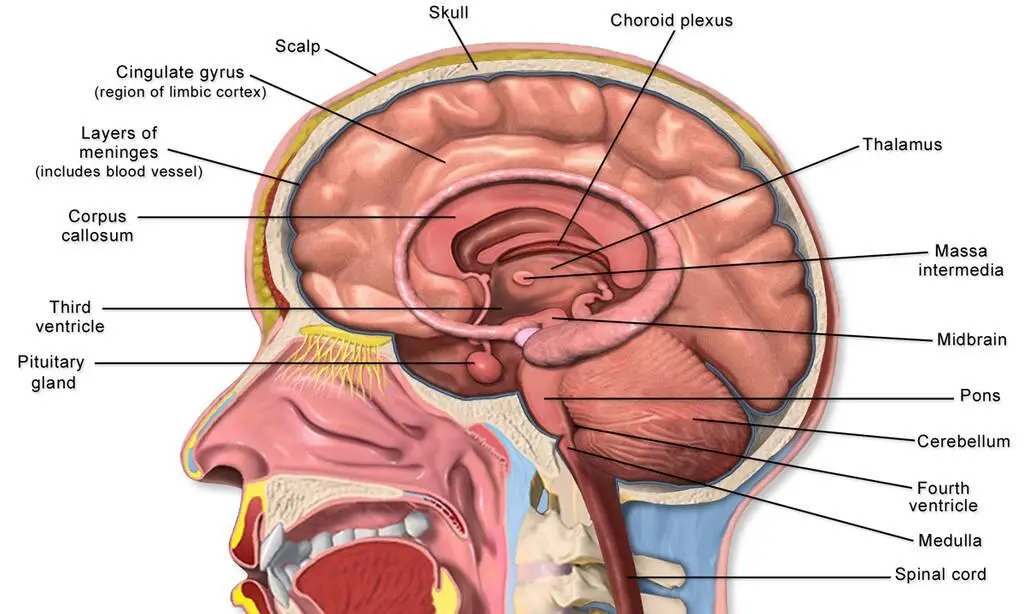
Fig. 1.
The most rough division is: the hindbrain, midbrain, and forebrain. In Latin this will be: rhombencephalon, mesencephalon, and prosencephalon. Going in down-top direction, rhombencephalon is further subdivided into myelencephalon and metencephalon and prosencephalon – into diencephalon (the intermediate brain) and telencephalon. Latin terms sound terribly, but fortunately they may be encountered mainly in very specialized literature. Myelencephalon is also called medulla oblongata (the oblong brain).
Another often term is the brain stem. It begins from the spinal cord and includes medulla oblongata, pons of the hindbrain, the midbrain, and sometimes diencephalon too.
The next tier of anatomy is more relevant to functionality.

Fig. 2.
The reticular formation is an elongate structure or a chain of nuclei spreading from medulla oblongata into diencephalon. The reticular formation is located in the middle of the brain stem and may be considered as its core.
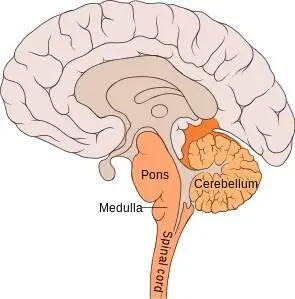
Fig. 3.
Metencephalon consists of cerebellum and pons. The former is also called a small brain because its structure is a simplified variant of the big brain. Pons means a bridge. It is formed by axons going to and from hemispheres of cerebellum. Important ascending and descending pathways obviously travel through pons. Also it includes the reticular formation and several specialized nuclei.
The dorsal part of the midbrain is formed by tectum that is the roof. It consists of the inferior and the superior colliculi (2 pairs of hillocks). The superior colliculus implements low-level visual processing. The inferior colliculus does the same for hearing.
If we need the line which separates peripheral devices from a computer case, it's here. With a few exclusions, what was named previously corresponds to controllers of periphery while the thalamus of diencephalon may be regarded as several expansion cards of PC.
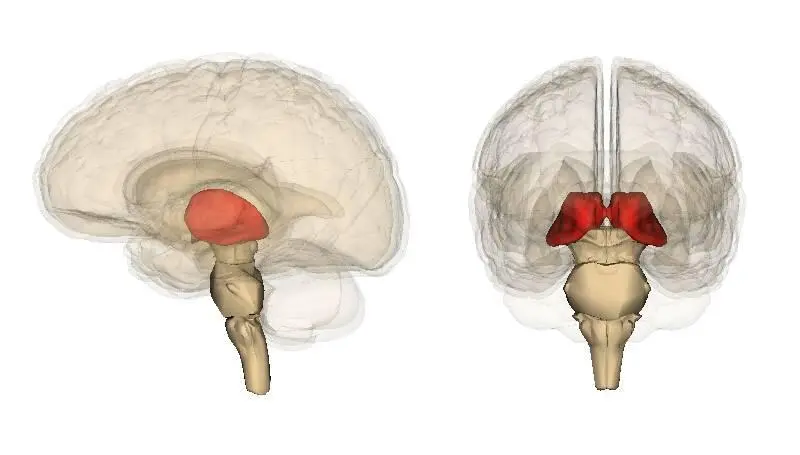
Fig. 4. The thalamus.
Below the thalamus resides the hypothalamus which plays a similar role, only in regard to internal bodily functions.
Remaining telencephalon is a motherboard of a neurocomputer. It consists of 2 almost symmetrical hemispheres. Each hemisphere is covered with the cerebral cortex – its visible surface. Basal ganglia are a complex of subcortical nuclei which are hidden beneath.

Fig. 5. Coronal cut of anterior section of the Brain showing basal ganglia.
Finally, anatomy names a complex which is defined not by proximity or similarity of its parts, but by strong connections between them.
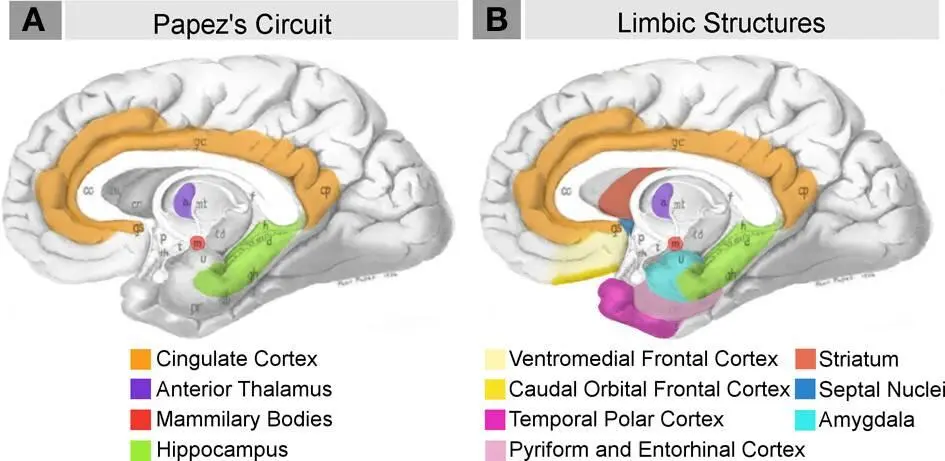
Fig. 6. Schematic briefly summarizing neural systems proposed to process emotion, highlighting structures that are visible on the medial surface of the brain. Papez's (1937) original circuit (A) was expanded upon in the concept of the limbic system (B) to include a variety of subcortical and cortical territories (MacLean, 1952; Heimer and Van Hoesen, 2006).
This is the limbic system. Its components are located in the midbrain and forebrain.
Computers are made of electronic components which were also known as radio details because before the advent of microprocessors computers were made of the same details as radio, TV, and other consumer electronics. Elementary components of the brain are neurons – specialized nerve cells which can generate electric pulses and conduct them to long distances of tens of centimetres. There are different types of radio details: resistors, capacitors, transistors, and a few others. Likewise, there are a few (of the order of 10) different types of neurons which may be repeatedly encountered in the different parts of the nervous system. The most substantial difference between them is that some are excitatory, others – inhibitory. That is, firing of the first neuron may force the second to fire too, or suppress its background firing rate instead. Neurons are not the only cells of the brain. There is also glia (which serves as damper for neurons and insulator for long wires – nerves) and blood vessels which are indeed a special type of muscles.
Читать дальше
